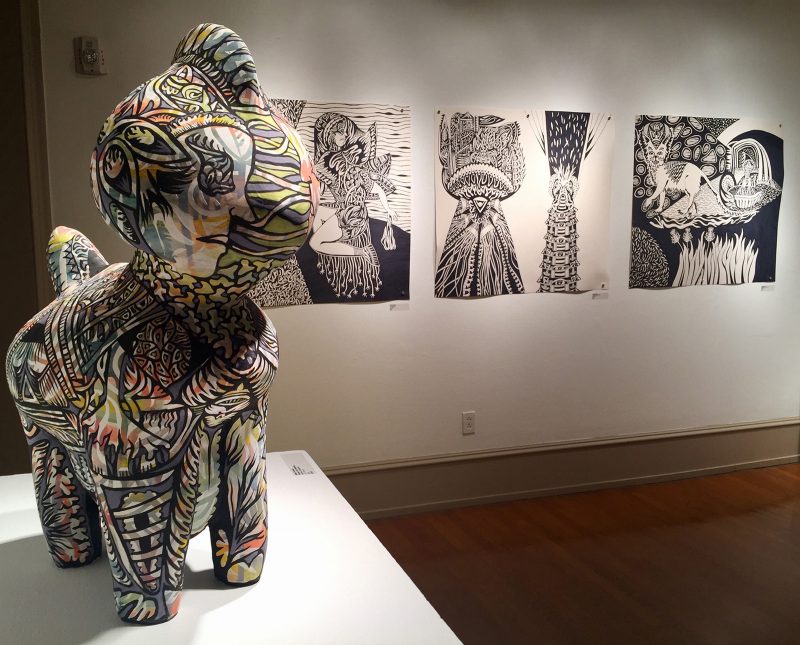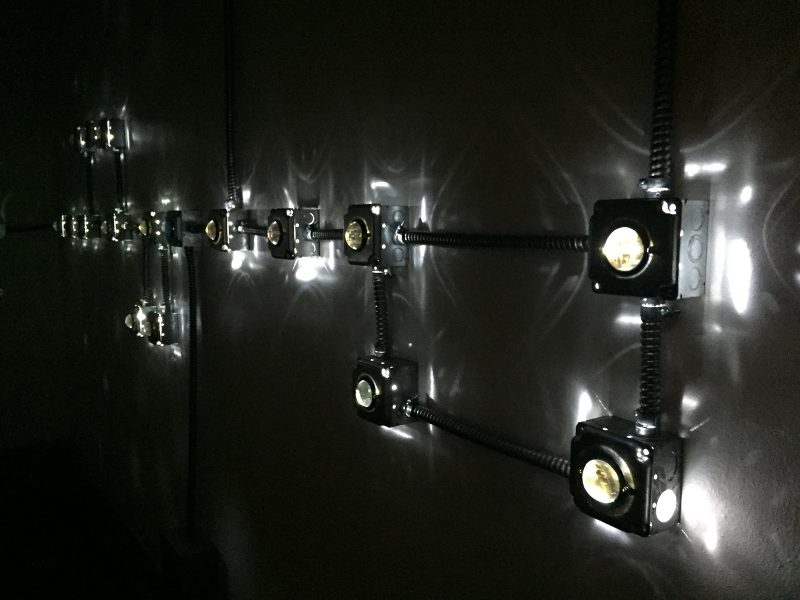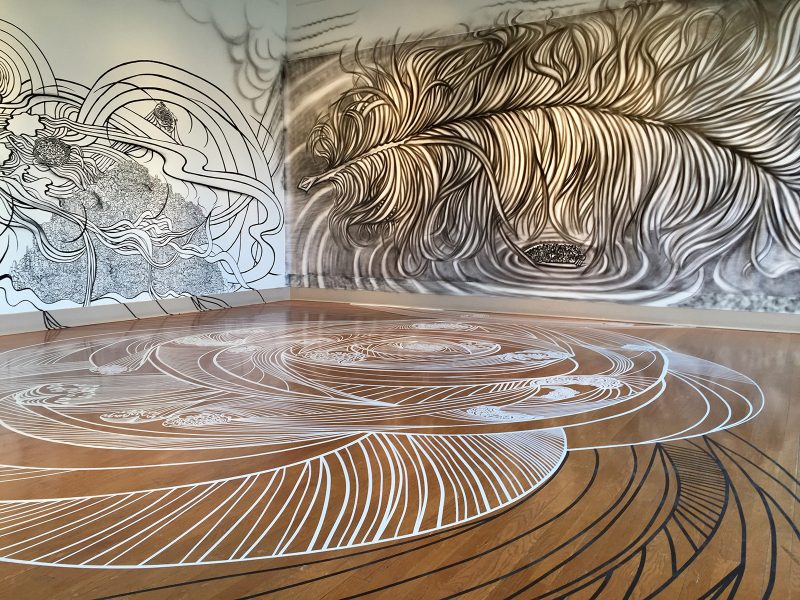The late artist-teacher Betsy Meyer encouraged artists to rethink their materials and consider especially how they could push the materials’ boundaries in order to create new ways to express themselves as artists.
Meyer passed away in 2004, but her encouraging spirit continues through the Betsy Meyer Memorial Exhibition and the Meyer Family Award for Contemporary Art, now in its 13th year at the Main Line Arts Center in Haverford. The award provides each winning artist a $1,000 award and a solo exhibition at MLAC. The award exhibition, Draw the Line, is up through April 15.
This year’s award winners—Kelley Donahue of Brooklyn, and Joanna Platt and Paul Santoleri, both of Philadelphia—are mid-career artists who work in a variety of media and exhibit nationally and internationally. They were chosen by Amy Potsic, executive director and chief curator of the Main Line Art Center along with the center’s 14-member board of artistic advisors.

Kelley Donahue’s whimsical clay critters
Kelley Donahue works intuitively, molding whimsical clay figures that are human, animal, or biomorphic hybrids. The artist adorns the figures with faces, hands, and other detached body parts surrounded by abstract or near-abstract repeat patterns in pastel colors punctuated with areas of dense black. She calls her fantasy environment, “Trans-Utopian Celestial Dream Pop,” and gives each piece a humorous name. I should note that Donahue has some equally whimsical and highly patterned ink drawings in the show.
A life-size pastel-patterned woman lays on her back on the floor with her legs up, ankles crossed in the air, in what might be construed as a sexual posture. The title: “Stop Talking about Making Magic (Just Make it).”
The artist’s mischievous nature was in full bloom at the exhibit’s March 6 opening. At the entrance of a room filled with her work, a pastel clay dog stood on a pedestal, titled “Seeing is Not Believing.” While the crowd gathered and mingled, Donahue surreptitiously left a number of pastel-designed, clay “deposits” behind the sculptural dog. By closing, six such “deposits” had appeared, greeted intermittently by chuckling guests.

Joanna Platt’s electric drawings
In another room, artist Joanna Platt’s “Timelines” uses an inspired choice of materials to “draw” with —electrical conduit attached to 42 junction boxes on four walls. Each junction box features a small half-globe through which you can watch videos of floating clouds, or gaze at still photos of interiors of homes, landscapes, or other objects.
I marveled at Platt’s mastery of the technical equipment, from the junction boxes and aluminum conduit to the lenses, LEDs, slides, digital video, LCD monitors, and more. Yet, her work results in a very intimate experience in which only one person can discover a view at a time. The video and still photographs are special memories of the artist’s, yet they are so familiar, they can also spark memories in the viewers.

Paul Santoleri’s lyrical take on the harrowing journeys of refugees
Muralist Paul Santoleri created a room-size drawing installation tackling the journeys of refugees, fraught with adversities while searching for faraway homes. His windswept feather-like drawing, called “Offering,” is front and center as you enter the room. A monumental 12-foot by 20-foot drawing on white paper covers the wall, with fierce feather marks as if gale-force winds are shaking the tiny crowded boat of refugees at the bottom.
Tiny villages of building blocks are depicted on a nearby wall and the floor, just out of reach. On an adjacent white wall, Santoleri extends a white paper drawing with marks of charcoal, spray paint, and acrylics. Same, too, with the hardwood floor covered with lyrical swirls of white vinyl stencils of huge flowers, titled “The Rose.” From the ceiling hangs an eight-foot overturned boat, titled “Tension Capsized,” with onboard Slinkys gone haywire.
And yet, Santoleri does not forget the refugees’ tiny pocket-sized treasures—stones, shells, marbles, and whatnot—in large glass jars, titled “Keepsakes 1” and “Keepsakes 2,” sitting on milk crates. They hide behind tall columns covered in brown paper with drawings of tiny villages.
The installation appears to symbolize the enormity of what refugees must go through on their long journey to find a safe, welcoming home.
While I chuckled at Kelley Donahue’s satirical clay figures and found the virtuoso drawing installation by Paul Santoleri a wow both for its graphic impact and its politically-charged subject-matter, it is Joanna Platt’s “Timelines” that moved me, with its simple message of connection. The idea of shared space, shared memories, and the suggestion that technology brings us together yet keeps us apart is something we all should ponder.
Draw the Line continues until April 15 at Main Line Art Center, 746 Panmure Rd, Haverford, PA.









